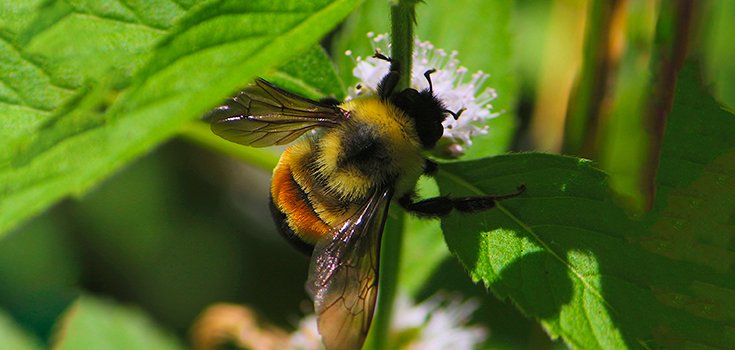Bees Need the Government’s Help, but the EPA is Oblivious

The rusty patched bumblebee has been declared endangered by the U.S. Fish and Wildlife Service, marking the first time a bee species in the continental United States has been categorized as such. [1]
The winged creature is in sharp decline, and the agency says it is in a race against time to save the species.
Wildlife Service Midwest Regional Director Tom Melius said:
“Listing the bee as endangered will help us mobilize partners and focus resources on finding ways right now to stop the decline.”
The speed at which numbers of the rusty patched bumblebees have declined is breathtaking. The population has shrunk 87% since the late 1990s, the wildlife service said. The bees reside in Illinois, Indiana, Iowa, Maine, Maryland, Massachusetts, Minnesota, North Carolina, Ohio, Pennsylvania, Tennessee, Virginia, Wisconsin, and Ontario, Canada.
Bees pollinate 35% of the world’s food, including tomatoes, cranberries, blueberries, melons, and many more crops.
Read: List of Foods we Will Lose if we Don’t Save the Bees
Pollinator bees are dying off around the globe due to habitat loss, climate change, and unchecked chemical use.
Melius said:
“The rusty patched bumblebee is among a group of pollinators, including the monarch butterfly, experiencing serious declines across the country. Why is this important? Pollinators are small but mighty parts of the natural mechanism that sustains us and our world. Without them … our crops require laborious, costly pollination by hand.”
Why isn’t the EPA Making more Moves to Protect Bee and Other Pollinators?
In the same week that the Fish and Wildlife Service listed rusty patched bumblebees as endangered, the Environmental Protection Agency acknowledged for the first time that 3 of the nation’s most-used neonicotinoid pesticides pose serious risks to commercial honeybees.
However, the agency also refused to restrict the use of any leading bee-killing pesticides, despite mountains of evidence that the chemicals contribute to the decline of pollinators. [2]
Where is the “protection” in the Environmental Protection Agency?
Released January 12, the EPA assessments conclude that clothianidin, thiamethoxam, and dinotefuran can kill bees and their larvae individually, but that in “most approved uses they do not pose significant risks to bee colonies.” [2]

The conclusions give growers the green light to keep using the chemicals, which are listed as ingredients in dozens of products.
Lori Ann Burd, director of the Center for Biological Diversity’s Environmental Health program, said:
“It’s outrageous that on the same day the EPA acknowledged these dangerous pesticides are killing bees it also reversed course on mandating restrictions on their use.
This is like a doctor diagnosing your illness but then deciding to withhold the medicine you need to cure it.” [3]
The bee policy “fails pollinators,” said Tiffany Finck-Haynes, food futures campaigner at Friends of the Earth, and should have been strengthened.
She added:
“If EPA is serious about protecting bees, the livelihood of beekeepers and our environment, the agency should take bee-toxic pesticides off the market.”
Each of these neonicotinoids have been have been linked to a dizzying decline in bee colony populations since 2006.
The class of pesticides are well-known for their acute and chronic effects on honeybees, birds, butterflies, and other pollinators, and are a significant contributor to overall pollinator declines. Neonicotinoids cause entire plants to become toxic to pollinators – even their pollen and nectar. These chemicals break down slowly and build up in the soil where they threaten thousands of species of ground-nesting native bees. [2]
According the biggest and most comprehensive global assessment of pollinators published in November 2016, neonicotinoids and other factors threaten to push 40% of pollinating insects into extinction.
The EPA’s determinations will certainly play a role in the creation of labeling requirements for the products under federal pesticide laws, which are expected to be finalized next year.
Those rules are strictly enforceable, but the agency’s bee policy is not. The bee policy merely suggests that users avoid spraying the chemicals when commercial hives have been brought in to pollinate blooming flowers. Such services contribute some $14 billion in value to the agricultural economy nationwide. [3]

Grower criticism drove the EPA to loosen its bee protection policy from an earlier draft, who argued that not every chemical remains in the environment for the same length of time and that not every crop has the same bloom period.
Read: Companies Hide Data Showing Neonicotinoid Products Cause Serious Harm to Honeybees
The state of California, which often has powerful influence over how other states act and react to policy, will likely “impose some kind of restrictions on the use of neonicotinoids on certain crops by the end of this year,” according to Charlotte Fadipe, spokeswoman for the state Department of Pesticide Regulation, which helped the EPA on the assessments.
Hopefully other areas of the country will follow in California’s footsteps.
Said Burd:
“The new policy does virtually nothing to protect America’s thousands of declining native bee species or to curb the escalating use of these harmful neonicotinoid pesticides across hundreds of millions of acres in the United States.
It’s shocking that the EPA’s response to the crisis of declining pollinators and the abundant science linking that decline to neonicotinoid insecticides is to meekly offer a policy encouraging industry to consider restricting pesticide use in limited situations where plants are blooming while commercial honeybees have been brought in to work the fields. This is a rejection of science that should be deeply troubling to all Americans as we move into a Trump administration.” [2]
Sources:
[1] CNN
